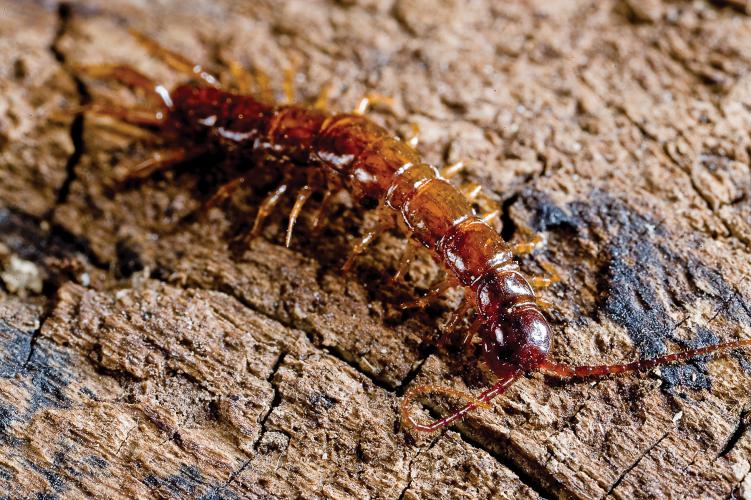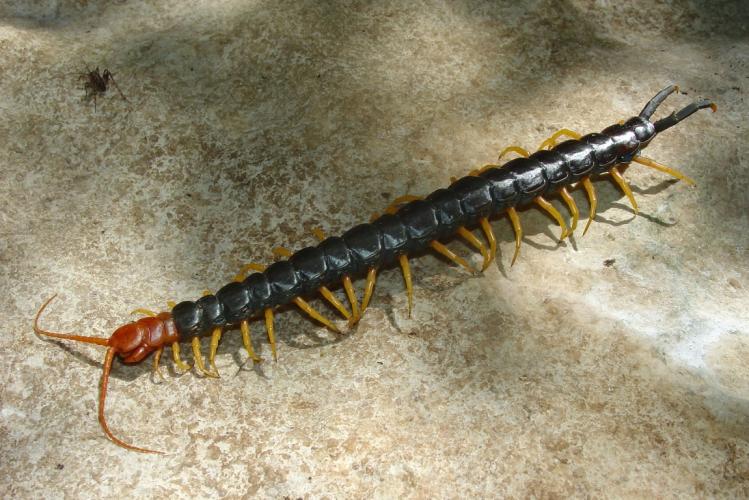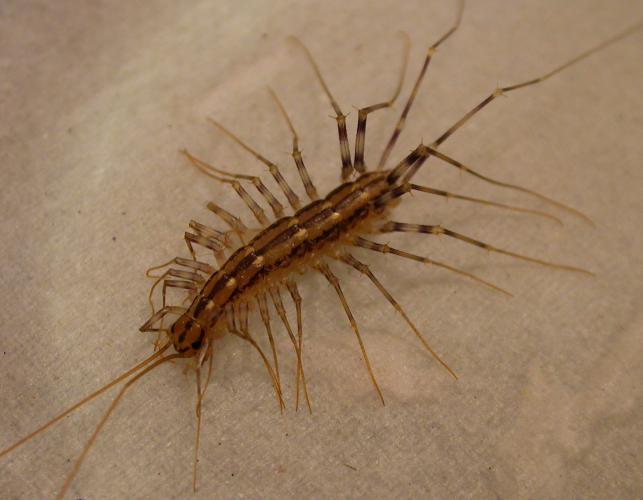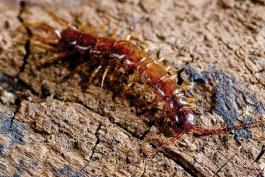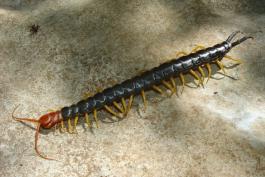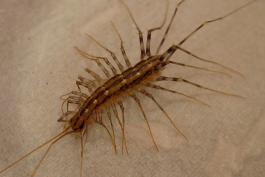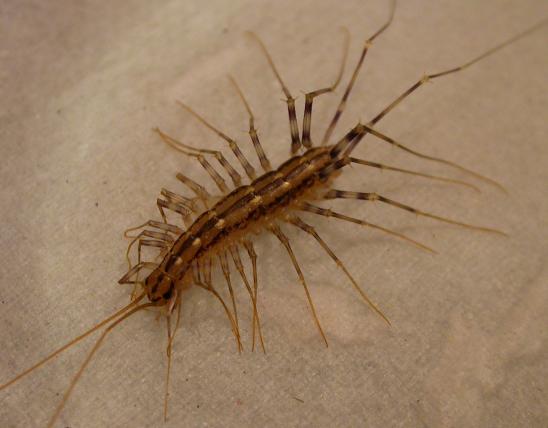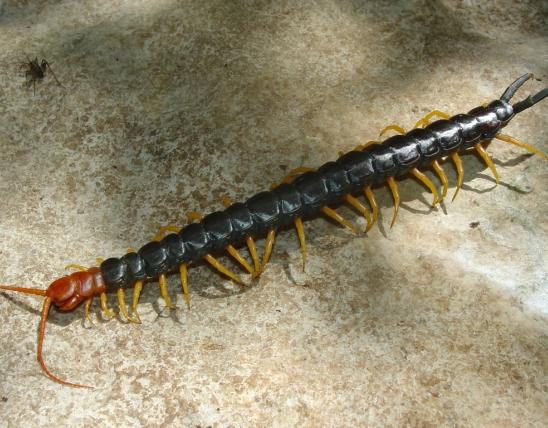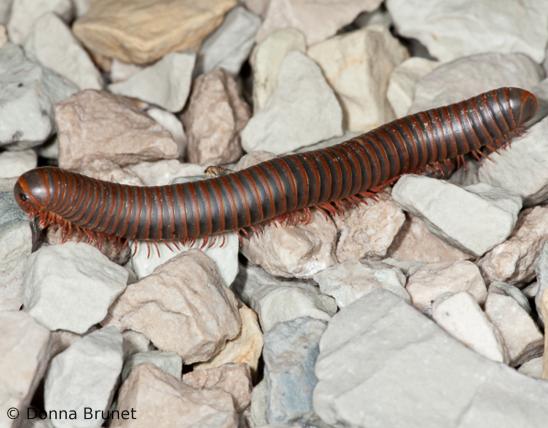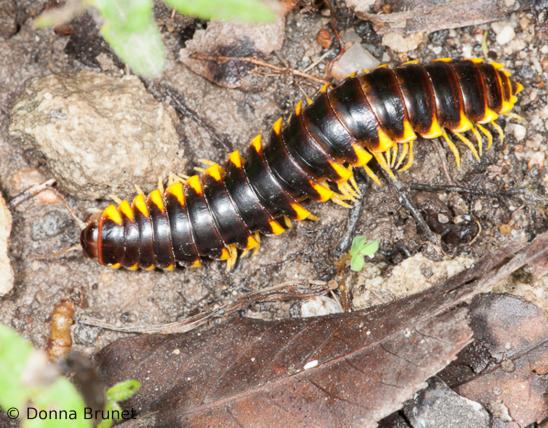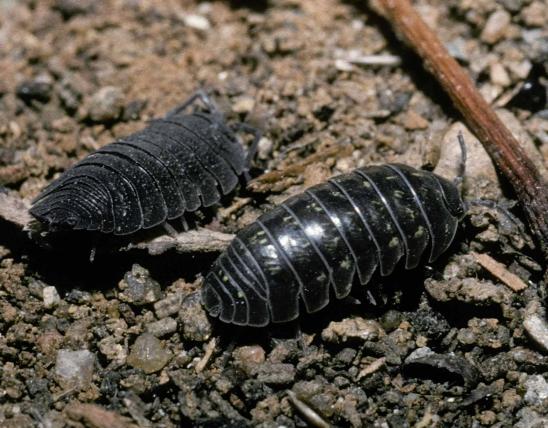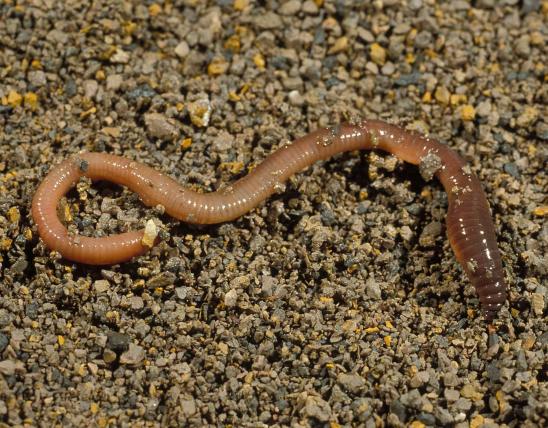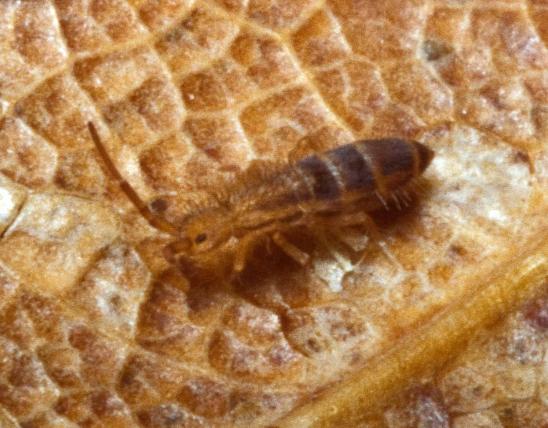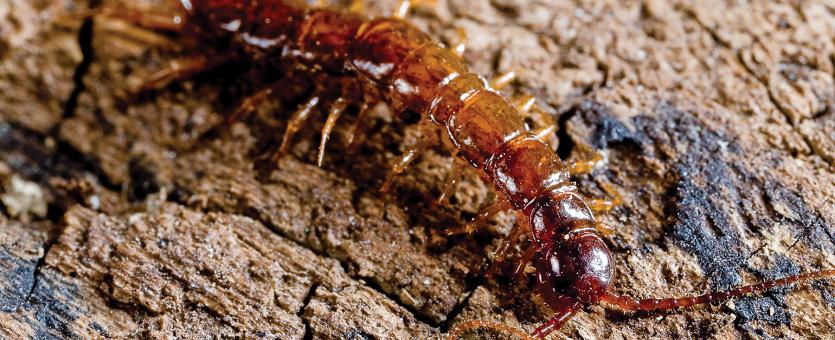
Centipedes are members of class Chilopoda (ky-LOP-uh-duh; some people say ky-luh-PODE-uh or chill-uh-PODE-uh). Within this class, there are many families, genera, and species worldwide. Centipedes are long-bodied, usually flattened, multi-segmented animals that have a single pair of legs on nearly all of their body segments. Although the name implies they have 100 legs, the actual number varies by species and by age and can range from 30 to 382 (or 15 to 191 pairs).
Though the main body segments are mostly all fairly similar, with a pair of legs on each, the front and hind portions of the animal are different.
The head is often flattened and has one pair of large, straight (not elbowed) antennae. Under the head, the mouth is covered by a pair of venomous, forward-bending, pincerlike claws (called prehensors or forcipules). These are used for capturing and subduing prey, but if you mishandle the larger species, they can inflict a painful bite — however, most of the small species are too tiny to bite you at all. Missouri’s centipedes are not considered dangerous to people. Vision varies among centipedes; some species are blind, having no eyes; others have simple eyes (ocelli), which help them detect light and dark; others have true compound eyes, but even then, the vision is very limited so that they do not see images, though they may be able to detect some motion.
The hind end of a centipede has the last pair of legs positioned so they point backward; thus they look something like a pair of antennae. Indeed, their basic function is sensory, so not only do they look like antennae, they function like them, too. Behind the last leg-bearing segment, the final few body segments are tiny, legless, and have organs for reproduction and excretion.
Globally, there are five orders (groups of families) in class Chilopoda. Four of the orders are represented in Missouri.
Soil centipedes, or earth centipedes (Geophilomorpha). This is the largest order of centipedes, with 14 families and an estimated 4,000 species worldwide. Length varies widely with species; bodies are relatively narrow. They are typically tan or pale, fitting for their life belowground. They lack eyes. Legs: 27 to 191 pairs. Antennae with 14 segments. As the name suggests, these centipedes live in soil. They can burrow nearly 30 inches deep. Compared to other centipedes, they are wormlike and rather slow-moving. Their burrowing movements are similar to those of earthworms, with the body expanding forward, the front end gripping the substrate, then the hind end contracting toward the front. The body segments are all the same length, and each leg-bearing segment has a spiracle (respiratory opening).
Stone centipedes (Lithobiomorpha). This order has 2 families, with more than 2,000 estimated species, worldwide. Like the house centipedes, the stone centipedes add segments as they molt and grow older. Upon hatching, they have only 7 segments; once mature, adults have 18 body segments and 15 pairs of legs. Most species have simple eyes (ocelli) while others are blind, especially those that live in caves. A key characteristic of this order is that, starting behind the head, segments 1, 3, 5, 7, 8, 10, 12, and 14 are much longer than the other segments, which appear almost like mere connectors by comparison.
Bark centipedes, sometimes called tropical centipedes (Scolopendromorpha). Usually fairly large, with 21 or 23 pairs of legs (varying with family) and antennae with 17 or more segments. Most have 4 simple eyes (ocelli) while others are blind. They can bite with their forcipules and also pinch with their last, backward-pointing pair of legs. There are about 27 species that occur in North America north of Mexico; most occur in the desert southwest or in the more southern, Gulf Coast states. Below are some examples of Missouri species:
- Giant redheaded centipede (Scolopendra heros), in Missouri, occurs only in our southernmost counties. May reach 8 inches in length; has 21 pairs of legs; has a black body, yellow legs, rusty-red head.
- Eastern bark centipede (Hemiscolopendra marginata) occurs in the eastern United States; to 3 inches long; has 21 pairs of legs; has a bluish cast, blue marks on pale yellowish legs, blue antennae, orangish hind legs, and rusty red forcipules.
- Eastern red centipede (Scolopocryptops sexspinosus) occurs in the eastern United States. Length to about 2¾ inches. Body and legs are red or rust colored, with 23 pairs of legs. It is completely blind.
- Common cryptops (Cryptops hortensis), narrow, reddish to pale brown, to about 1¼ inches long; native to Europe and widely introduced in North American cities. Has 21 pairs of legs, no eyes; hindmost pair of legs are thickened.
- White-footed cryptops (Cryptops leucopodus). Occurs in the eastern United States. Quite similar to common cryptops, though pale yellow or gold, not red. Unlike common cryptops, this species is native to North America.
House centipedes (Scutigeromorpha). Fast-moving, with compound eyes and relatively long legs and antennae. Adults have only 15 pairs of legs, which are banded. The bodies are not particularly flattened. There is one species that is common in Missouri: the house centipede (Scutigera coleoptrata). It is common in basements and cellars; in nature, it occurs under rocks and logs and in other protected areas.
Similar species: Millipedes (class Diplopoda) are the group most likely to be confused with centipedes. Millipedes are easily distinguished by their more cylindrical (not flattened) bodies, their elbowed antennae, and their having 2 pairs (not 1 pair) of legs per body segment.
Another similar group, which you’ve probably never heard of, are the symphylans (class Symphyla). Also called dwarf millipedes, garden centipedes, and symphylids, they resemble tiny, soft, white centipedes and only reach about ¼ inch long. Like centipedes, they have 1 pair of legs in each of the main body segments. The antennae are slender, sensitive, with many segments. Mature adults have 12 pairs of legs; hatchlings have 6 pairs. Often found in greenhouses and may be pests, as they can damage plant roots.
Adult size varies with species. Most are only about ½ to 1 inch long. Our largest species, found only in our southernmost counties, can reach 8 inches in length.

Statewide. Different species have different habitat preferences and therefore may have different distribution patterns within the state.
Habitat and Conservation
Centipedes occur in a wide variety of habitats — even deserts — but they almost always are confined to damp, moist, humid locations within those habitats. Some centipedes live only in caves.
Centipedes, like millipedes, have bodies that are vulnerable to drying out, so they are almost always restricted to moist habitats such as soils, leaf litter, or under rocks, logs, or bark. In the case of house centipedes, the habitat might be a cool, damp basement. Centipedes’ typically flat, extremely flexible bodies and many short, backward-pointing legs allow them to move easily through soil and squeeze into tight crevices.
Centipedes have moisture-seeking and dryness-avoiding behaviors. They burrow into soil, avoid bright light, move toward dark places, are active only at night, and move quickly to safety as the humidity drops. Some can even enter an inert state when the environment gets too dry.
The reason they are prone to drying out is that their outer cuticle lacks a waxy-like coating that prevents water loss. Also, each body segment’s spiracles (respiratory openings) cannot be closed, so dry conditions can quickly dry them out. Centipedes and millipedes also tend to lose moisture as they chew and as they defecate.
Food
Centipedes are predaceous. They use their sensitive antennae to detect prey, then impale it with their venom-bearing forcipules. With the prey subdued, they shred and consume it with their chewing mouthparts. Most Missouri species, which are small, capture and eat small insects, springtails, spiders, earthworms, snails, nematodes, and other invertebrate animals. Centipedes are generalists, consuming any prey small enough for them to subdue. Thus the largest centipede species are capable of eating larger prey, including small vertebrates such as small toads, snakes, and mice.
Status
Taxonomically, centipedes are members of a class — a group that is smaller than a phylum and larger than a family. The phylum they belong to is Arthropoda. The arthropods are a huge group of invertebrates that have jointed legs and exoskeletons; arthropods include crabs, crayfish, shrimp, and other crustaceans; insects; spiders and their relatives; silverfish; springtails; and so on.
To get an idea of scale, consider this: In addition to centipedes, other arthropod classes include the insects (such as beetles, butterflies, flies, grasshoppers, etc.), the arachnids (such as spiders, scorpions, mites, harvestmen, etc.), and the malacostracans (the largest class of crustaceans, including shrimps, crabs, pillbugs, amphipods, etc.).
Centipedes are grouped with 3 other classes (millipedes, pauropods, and symphylans) into a subphylum called Myriapoda (the many-legged animals). All have numerous, rather repetitive body segments, and most groups have one or two pairs of legs per segment. It's easy to see how their wormlike bodies are different from those of insects, spiders, and crustaceans.
Life Cycle
Males deposit a sperm packet (spermatophore), which the female picks up. In some species, the males perform a courtship dance to entice females to accept the spermatophore, while in others the females discover the spermatophores fairly randomly.
Egg deposition varies widely. In some groups, females lay eggs singly into holes in the ground and crawl away, while females in other groups show parental care, remaining with up to dozens of eggs, defending them from predators and cleaning them to keep fungi at bay. In some species, the mother stays with the young after they hatch, continuing to protect them until they’re ready to be on their own.
The different orders of centipedes have different main growth patterns. In the stone centipedes and house centipedes, hatchlings have fewer body segments and legs than adults, and as they grow and molt, they gradually gain more segments and pairs of legs, until they reach a maximum, mature adult size. This development pattern is called anamorphic.
An alternative development pattern is called epimorphic; in this case, all the segments and pairs of legs are fully developed in the egg, so all individuals of a species, regardless of their age, have the same number of segments and legs throughout their life. They do not acquire new pairs of legs as they molt. Individuals within a single species, however, may have different numbers of pairs of legs, within a set range — say, from 15 to 191 — but the pairs are always in odd numbers. The centipede orders that have epimorphic development are the soil centipedes and the bark/tropical centipedes.
Lifespan varies with species. Some can live for more than 10 years.
Human Connections
Soil centipedes influence the soil in ways that benefit humans.
Many people are frightened by centipedes, but the fear is almost completely unwarranted. Except for the very large species, they are harmless to people. However, any animal with venom should be handled with care, even if the venom is not considered dangerous to humans.
Among Missouri’s centipedes, the one of most concern is the giant red-headed centipede (Scolopendra heros), found only in our southernmost counties. Its bite can be intensely painful and can cause swelling, though it is usually no worse than a wasp or scorpion sting. But infants, the elderly, or people in poor health could potentially be harmed by this animal and may need to seek treatment. Also, certain individuals, if bitten, may have an allergic response that requires immediate medical treatment. If you are bitten by any venomous animal, including centipedes, wasps, or bees, and you have difficulty breathing, seek medical treatment immediately.
The great majority of Missouri’s centipedes are tiny to small and are usually of little concern. In many cases, they are so small they cannot break human skin. Take care, however, if you travel to tropical or desert regions, where larger, more formidable species may be present.
Interesting fact: if you count the pairs of legs on a centipede — any centipede — you will find it is always an odd number: 15 pairs, 17 pairs, 45 pairs, and so on. (Remember, the hindmost pair of legs point backward and are taillike.) Because 50 is an even number, a centipede can never have exactly 100 legs.
One of the classic arcade video games of the 1980s was called Centipede. It included several figures from nature, including mushrooms, spiders, a water boatman, scorpions, fleas, and of course, centipedes. The game was far from an accurate depiction of nature, as real centipedes do not regenerate if cut in two, nor do they regrow their heads.
Ecosystem Connections
Centipedes are an important component of healthy soils, as many centipede species burrow, live, and die underground. Their tunnels help rainwater to soak into the earth. They prey on tiny animals and in turn are preyed upon by larger animals such as shrews, moles, lizards, toads, and small snakes.
Centipedes are the only life-form on earth that possesses forcipules, forelegs modified into venom-delivering pincers. Although they look like a part of the mouth, the forcipules are technically maxillipeds — modified leglike appendages near the mouth that usually help with feeding. On crayfish, the analogous appendages (maxillipeds) are 3 pairs of small, point-tipped, fingerlike structures near the mouth.
Centipedes are preyed on by a variety of animals, including shrews, mice, salamanders, and snakes.
Most centipedes have glands that emit sticky, toxic, or otherwise repugnant chemicals to defend against predators.
In addition to the four orders of centipedes discussed here, there is a fifth order that occurs only in Tasmania and New Zealand. This order, Craterostigmomorpha, has only 2 living species and has its own unique development pattern: in their first molt, they go from 12 leg-bearing segments to 15, and then that’s it. They don’t add any more legs. Thus their development is intermediate between the two anamorphic orders (that acquire additional pairs of legs over a number of molts) and the two epimorphic orders (that hatch with all their legs already present). The oddball status of these New Zealand centipedes has led people to liken them to the duck-billed platypus.
Not counting extinct and fossil species, the largest centipede in the world is a species that lives in South America. The Amazonian giant centipede (Scolopendra gigantea) can exceed 12 inches in length and can eat vertebrate animals such as frogs, lizards, mice, bats, and birds.
Centipede fossils date all the way back to the Late Silurian period, 430 million years ago. They, the millipedes, and other close relatives are some of the earliest known animals to live on land.
